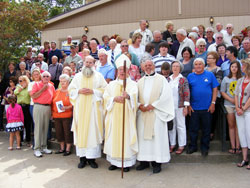Perry County parish celebrates 175 years of faith

Father Brian Esarey, left, retired Benedictine Archabbot Lambert Reilly and Father Mark Gottemoeller pose on Sept. 16 with members of St. Augustine Parish in Leopold on the grounds of the Tell City Deanery faith community after the celebration of a Mass to mark the 175th anniversary of its founding. Father Esarey is its current pastor. Father Gottemoeller is one of its previous pastors. Archabbot Lambert was the principal celebrant at the anniversary Mass. (Photo by Patricia Happel Cornwell)
By Patricia Happel Cornwell (Special to The Criterion)
LEOPOLD—Members of St. Augustine Parish in Leopold celebrated the 175th anniversary of their Perry County faith community on Sept. 16 with a special Mass followed by a dinner and displays of historic photographs. The parish, founded in 1837, is five years older than the town.
Retired Benedictine Archabbot Lambert Reilly of Saint Meinrad Archabbey in St. Meinrad was the principal celebrant at the Mass. Father Brian Esarey, current pastor, and Father Mark Gottemoeller, former pastor, concelebrated. Benedictine Father Julian Peters was master of ceremonies.
The parish was established when Father Julian Benoit built a log church and called it “The Chapel.” He was succeeded in 1840 by Father Auguste Bessonies, who then founded the town in 1842 with funds provided by Bishop Simon Bruté of Vincennes. The present stone church was completed in 1872.
In his homily, Archabbot Lambert noted that the first pastors in southeastern Indiana were circuit riders who served the people in far-flung communities, traveling on horseback with only “directions carved on trees.”
Archabbot Lambert referred to a difficult period of anti-immigrant and anti-Catholic sentiment in the 1850s. “There was open rebellion in Leopold, and people ridiculed the Church and the pastor,” he said. “The Know-Nothing Party decided there was too much religion being taught so they set fire to St. Augustine Church and rectory. The townspeople rushed to extinguish the flames. The parish only grew stronger.
“What has held it all together?” the archabbot said. “The answer is in the Gospel. When Jesus asked, ‘Who do you say I am?’ Peter replied, ‘You are God. You are the Savior of the world’ (Mk 8:29).
“We are all pilgrims wherever we come from. We are all on the road to heaven,” Archabbot Lambert said. “In case you didn’t know it, Leopold is not heaven. And St. Augustine’s is not heaven. But they are gateways to heaven. Our ultimate reunion is in heaven, and then this town and this parish will certainly be ‘on the map.’ ”
Fifteen miles north of the Ohio River, Leopold is an unincorporated village of fewer than 100 residents. Its main structures are the church, a general store and a restaurant. The biggest event of the year is the church picnic, which takes place on the last Sunday of July.
To the left of the altar in St. Augustine Church is a shrine to Our Lady of Consolation, which has both spiritual and historical significance to the community.
According to history buff and parishioner Judy Edwards, during the Civil War three parishioners survived incarceration at the Confederacy’s notorious Andersonville Prison in Georgia. The men vowed that if they were ever released, they would make a pilgrimage to their native Luxembourg and have a replica made of the statue of Mary in their ancestral church.
After the war, they made the voyage and returned with the components of the small, ornately dressed statue that is still displayed in the parish church.
“They came back with a head, a crown, two arms, baby Jesus, and a stone slab for a body,” Edwards said.
In 1960, a larger replica of Our Lady of Consolation was installed outside the church. A grotto is under construction to preserve the marble statue from further weathering.
Several descendants of the Andersonville survivors, including some from Germany, came to Leopold for the anniversary weekend. A genealogy session was held on Saturday at the parish hall.
Most of the original settlers of Leopold were French-speaking, Catholic immigrants from southern Belgium, who came to America after their region came under Protestant rule in the 1830s as a result of the Belgian revolution. Father Bessonies named the town for the king of Belgium, Leopold I.
St. Augustine Parish is currently comprised of 156 households. Father Esarey also serves St. Martin of Tours Parish in Siberia with 62 households, and Holy Cross Parish in St. Croix with 60 households. The parishes are all in Perry County.
Father Esarey, a native of Perry County, was assigned to the three parishes a little over a year ago. He said he never expected to return to the region as a pastor.
“My own family is one of the oldest in the county,” he said. “Being assigned here was like coming home, but it was a little challenging. Many of my parishioners are people I knew in my younger days.” They include his high school principal, classmates and some of his cousins.
The pastor described his parishioners as “very kind and selfless people. If you ask them to help with something, they will. They are very dedicated to their parish and to their community. There’s a great sense of history here.”
Debbie Kelly, 60, a St. Augustine parishioner since she was 18, is the mother of six children. “I taught fifth-grade catechism for about 10 years,” she recalled. “My sister-in-law did, too. And my daughter started teaching catechism this fall. We’re trying to get the next generation involved.
“By the time the town is 175 years old,” she added, “we hope to have a big history book completed. It’s amazing how much history is in this town.”
(Patricia Happel Cornwell is a freelance writer and a member of St. Joseph Parish in Corydon.) †
